OPOLO Cosmos Wallet Review: Complete Overview
Given the trends seen in financial markets and global economies it’s a fairly safe speculation to say that the world is migrating towards the increased adoption of digital currencies, and all that entails.
One of the major concerns as more people begin to hold and use cryptocurrencies is the security of their funds. Adoption cannot continue if people worry that the coins they hold can easily be stolen by any hacker with some small skill set.

Just looking at the image above and you can see why hardware cryptocurrency wallets are gaining importance. As the most secure way to store your cryptocurrencies more and more people are sure to be turning to hardware wallets in the coming months and years. However not all hardware wallets are created the same.
Some are certainly more secure than others, and while the big names have been around for several years, in this industry a long life doesn’t mean you’re the best. Innovation in the blockchain industry occurs at warp speeds and there’s always something new around the corner.
In this case the something new is the new OPOLO Hardware wallet. Designed to be not only the most secure hardware wallet in existence, but also designed for ease of use, the OPOLO Hardware wallet is currently in its crowdfunding pre-launch stage, which is perfect because it means you can still take advantage of a 51% discount until the wallet officially launches.
Of course you don’t want to purchase blindly, which is why we got our hands on a pre-launch OPOLO wallet to test out and review. We think you’ll be suitably impressed.
And once you get to the end of the review you’ll find a special offer where you can possibly also get an OPOLO for free!
OPOLO Hardware Wallet Key Features
Before we get into the detailed review of this next-generation wallet let’s take a look at some of the key features that separates the OPOLO Hardware wallet from the pack:

- The Opolo Hardware Wallet has the most secure hardware chip available which has been CC EAL 6+ certified.
- It is the first and only cryptocurrency hardware wallet to be audited and certified by Digital Security Paris.
- OPOLO shards backups and uses magnetic mnemonic backup storage to ensure you don’t lose access to your funds.
- Large 3.2 inch LCD touchscreen display makes it an easy task to enter passphrases and passwords.
- Passwords can be up to 120 characters long for better security.
- Currently has native support for 120 coins and 200,000+ tokens.
- User-friendly design uses a single wallet and a single app.
- Crypto-to-crypto and fiat-to-crypto exchange built-in.
- Secure Password Manager to store passwords and 2fa keys.
- Works with Android devices, Windows, Linux, and MacOS.

OPOLO Hardware Wallet Specifications
| SE | Secure Element with CC EAL6+ Certification |
| DIMENSIONS | 89.2 Mm X 66.4 Mm X 9.5 Mm |
| CONNECTION | USB Type C (V0), USB Micro (V1) |
| TOUCH DISPLAY | 79 Mm X 56 Mm |
| WEIGHT | 79 G |
| CPU | Embedded ARM Processor (CORTEX- M4) |
EAL6+ and IOT Secure Label Certification
In case you haven’t heard of EAL+ before, it is a certification given based on the results of a security audit that follows a Common Criteria security evaluation. The Secure Element manufactured by NXP is EAL6+ certified. The EAL+ audit assigns a score of 1-7 to the device or software, with the score of 1 the lowest and indicating only that the device or software is functional, while the highest score of 7 is applicable only where there is a high risk situation.
As you might expect the lower ratings of 1, 2 or 3 would leave your funds at a greater risk of hacking. The higher ratings of 6 and 7 mean the device and/or software that was audited is almost impossible to hack.
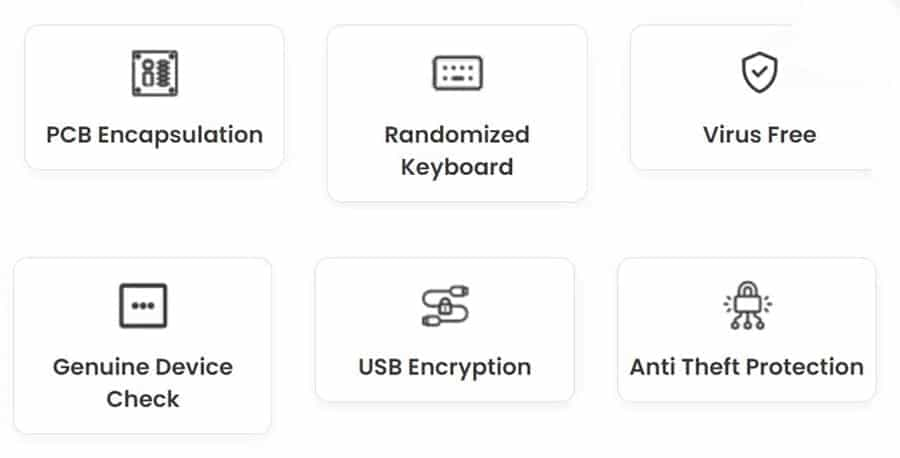
The OPOLO Hardware wallet uses a Secure Element with EAL6+ security certification. This gives high assurance from application of security engineering techniques to a rigorous development environment in order to produce a premium product for protecting high-value assets against significant risks. In addition, the security of the OPOLO Software and Hardware is audited by Digital Security, ATOS group, Paris, France for the IOT Secure Label certification.
As a comparison, the popular Ledger Nano X has only been certified to EAL5+ and the Trezor hasn’t been certified at all as it doesn’t include this type of Secure Element as part of its design. No other hardware wallet has undergone such rigorous auditing and testing before being launched.
The Secure Element (SE)
Secure Elements chips are the same chips used to secure your credit and debit cards from data leaks. The chip is responsible for handling secure payments and transfers by encrypting all the data handled by the chip. You can think of it like the secure vault in your hardware wallet. It protects all the coins you hold on the OPOLO Hardware wallet against potential malware attacks.
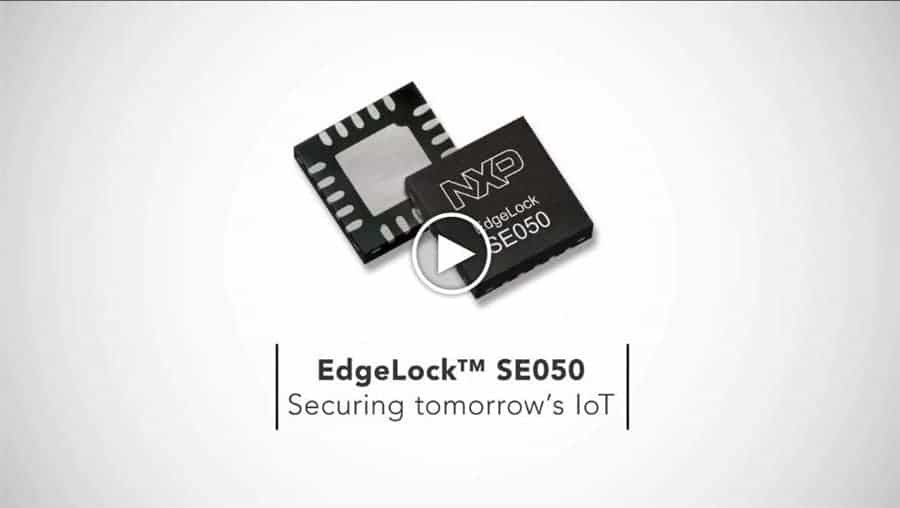
With the combination of these Secure Element chips and the EAL6+ certification the OPOLO wallet is one of the most secure and safest wallets currently available.
Secure Passphrase/Password
One of the software features that makes the OPOLO harder to crack is the secure passphrase. This passphrase is never saved on the device, meaning even if a hacker could get access to the device they would never be able to find the passphrase, because it simply isn’t present on the device. Even if they would have somehow gotten your password, without the passphrase your coins remain safe and secure.
Adding to this security is the password itself, which can be set as long as 120 characters. As you might have guessed already, the longer the password is, the more secure it is as well. Longer passwords are considerably harder to crack when compared with shorter passwords.
Moreover, there are only 7 chances allowed to input the password correctly. If someone inputs the password or passphrase incorrectly the device locks and wipes itself. At this point your wallet can only be restored to a new device.
In regard to that mnemonic phrase, the OPOLO Hardware wallet strikes another first as it is the only hardware wallet that includes backup sharding of the mnemonic phrase using the included magnetic cards. In order to save the mnemonics on the magnetic card all that is required is to place the OPOLO wallet on top of the magnetic card.
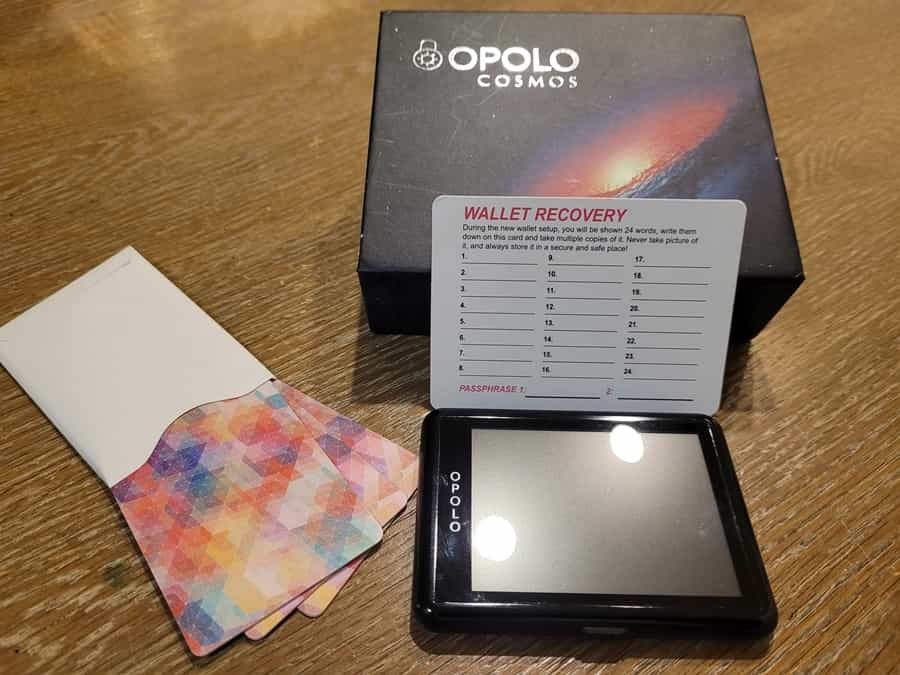
Place the OPOLO card under the device (on the backside) and press “Next”, on a successful backup, you will see a message with success. If you get a failure, readjust the position of OPOLO Card on the backside of the device and press “Retry.” When you successfully save the mnemonics on the card, please carefully store it in a very secure location. Someone who gets the card can restore the wallet. Please consider it as a paper, with mnemonics written on it.
If anything happens to the device (loss or damage of any kind) you will be able to use these 24 words to recover your funds and import the data into a new device (it can even be a different brand, if you wish).
Large Touch-Screen
The OPOLO’s touch-screen is a full 3.2 inch touchscreen that will allow even those of us with large, clumsy hands to input passwords and passphrases with ease. If you’ve ever used a hardware device with a tiny screen you’ll know how important this is. As you can see from the photo below the device is roughly the size of a standard computer mouse, which means it will also fit nicely in your hand.
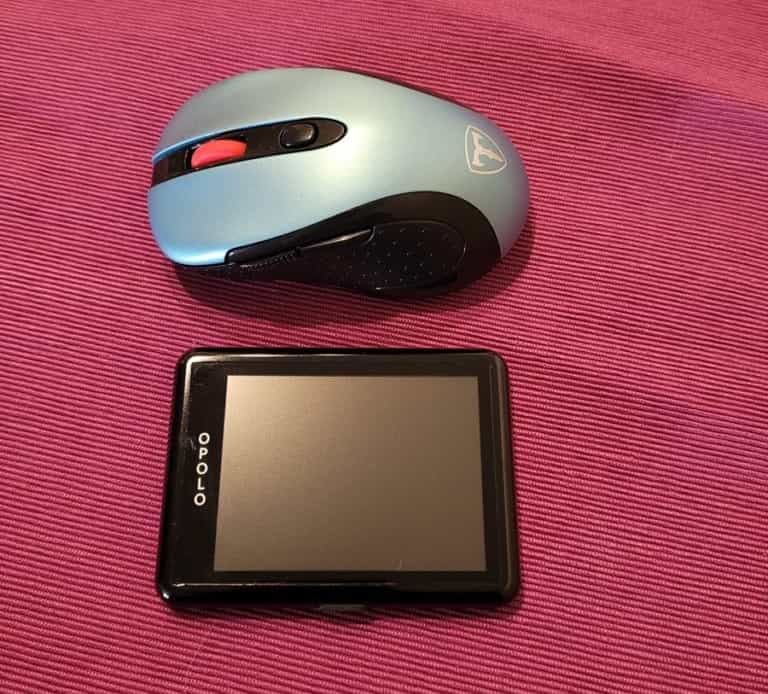
In addition the OPOLO was made very simple to use. Rather than requiring a number of plug-ins and apps and other wallets all you need for OPOLO is a single app. It can be installed on your desktop computer or on an Android smartphone and will show you all your coins in one easy to read dashboard.
This makes it far easier than Ledger or Trezor. You can easily display the receiving code for any coin, including its QR code or the full alphanumeric code if you prefer. Security is also maintained by requiring the entry of your passcode at any time you make a transaction with the device.
120+ Coins and 200,000+ Tokens
One of the most tedious parts of using a hardware wallet is the need to download so many different wallets and plug-ins and integrating coins onto the wallet. If you have more than a couple different coins (and who doesn’t), this all just seems like such a huge pain. OPOLO changes all that.
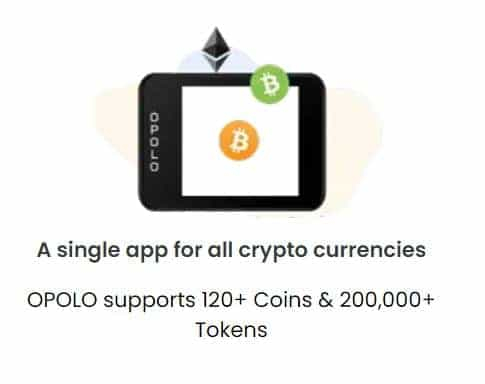
The OPOLO can hold over 120 different coins and more than 200,000 tokens. More coins and tokens will be added with every new update too. So there’s a very good chance that no matter what coin you’re hodling, the OPOLO is ready to let you store it easily and with no hassles.
This is really just part of the friendly user interface to be found with the OPOLO Hardware wallet. Who wants to spend hours downloading (and later updating) wallets and then integrating them with your hardware wallet to support many different cryptocurrencies? Plus this feature keep the wallet more secure by avoiding the need to download additional software from potentially untrustworthy third-party sources.
The OPOLO Team
Fahad Fazal is the founder and CEO of OPOLO Wallet. He is a serial entrepreneur and technologist with a PHD in Artificial Intelligence and Neural Networks from the University of Oslo. He has acted as a blockchain advisor and ICO advisor for a number of projects over the past several years.

Julien Vanel is the co-founder of OPOLO Wallet and the current CSO of the company. He has been working in the IT security field since 2000, in the finance, military, industry and services sectors. cryptosphere since 2018 through mining, investing and hodling.
Mickael Damour an advisor to the OPOLO wallet team. He is both an experienced blockchain enthusiast and an entrepreneur. He has been working for and advising blockchain based projects since 2014.
OPOLO Harware Wallet Applications
The OPOLO Desk application will allow you to interact seamlessly with your hardware wallet. Buy, sell, and exchange any of the supported cryptocurrencies quickly and easily. As far as wallet software goes this is very well designed and intuitive, which is a pleasure.
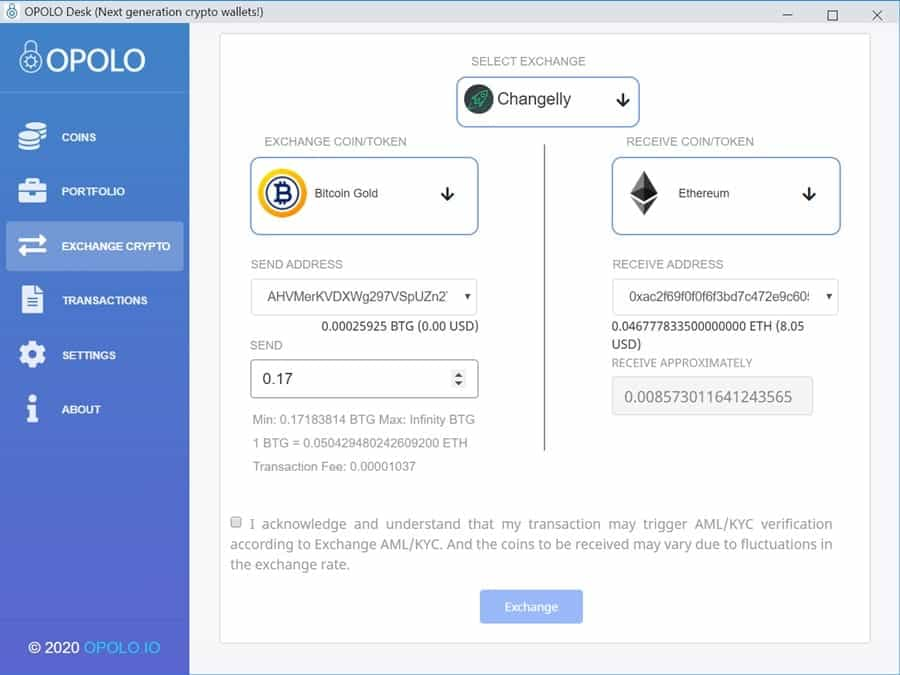
Currently the application is available for desktop computers running Windows (64-bit), Linux (64-bit), and MacOS (Sierra 10.10 and above). There’s also a mobile application for Android devices, however iPhone and iPad users are out of luck for the time being, and I haven’t seen any forecast for the release date of an iOS app.

The application also includes a Secure Password manager to make it easier for storing 2FA keys and passwords. It’s not a necessary function to be sure, but it is a nice little addition to make things simpler for users while maintaining the security of the device.
OPOLO Hardware Wallet Setup
Once you receive your OPOLO wallet you’re naturally going to want to get it setup so you can begin using it. The first fun step is the unboxing where you’ll get to see the hardware wallet itself, along with all the added peripherals and such.
In addition to the OPOLO wallet you’ll get a card for writing down your mnemonic, three magnetic cards for storing that same mnemonic, a USB type A to type C connector and a USB type C to type C connector. There are also two converters included, one for USB type A to USB 2.0 type C micro and one for USB 3.0 type C micro.
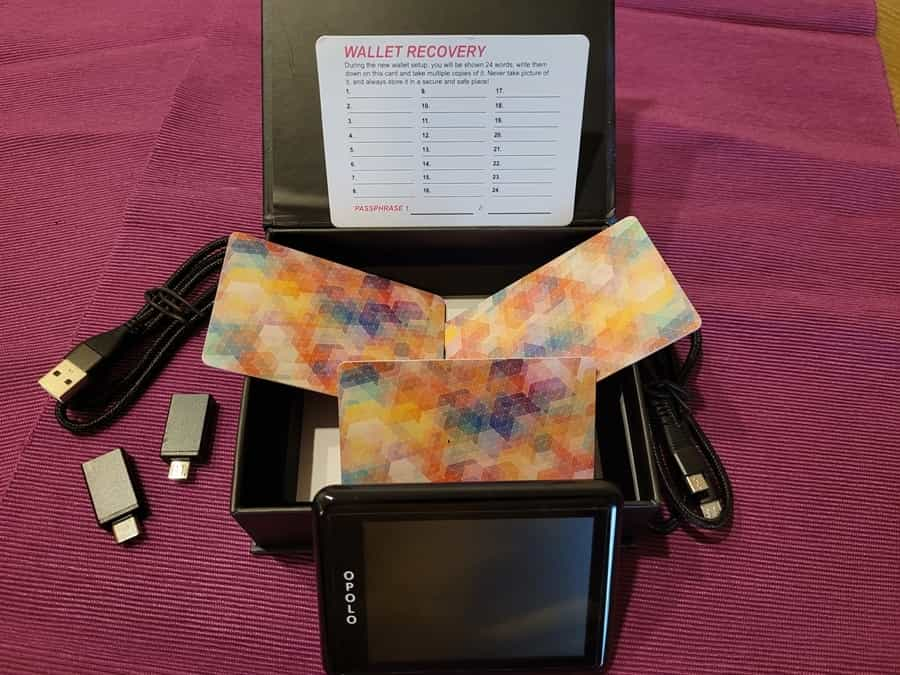
The first step is to use the a USB type A to type C and plug the OPOLO wallet into your desktop computer. It’s easy enough since there’s only one jack in the device. The smaller type C connector gets plugged into the wallet and the larger type A connector gets plugged into your computer USB port.
Immediately you’ll be presented with a screen asking if you’d like to setup the password. Choose “Yes” and go on to setup the password for the device.
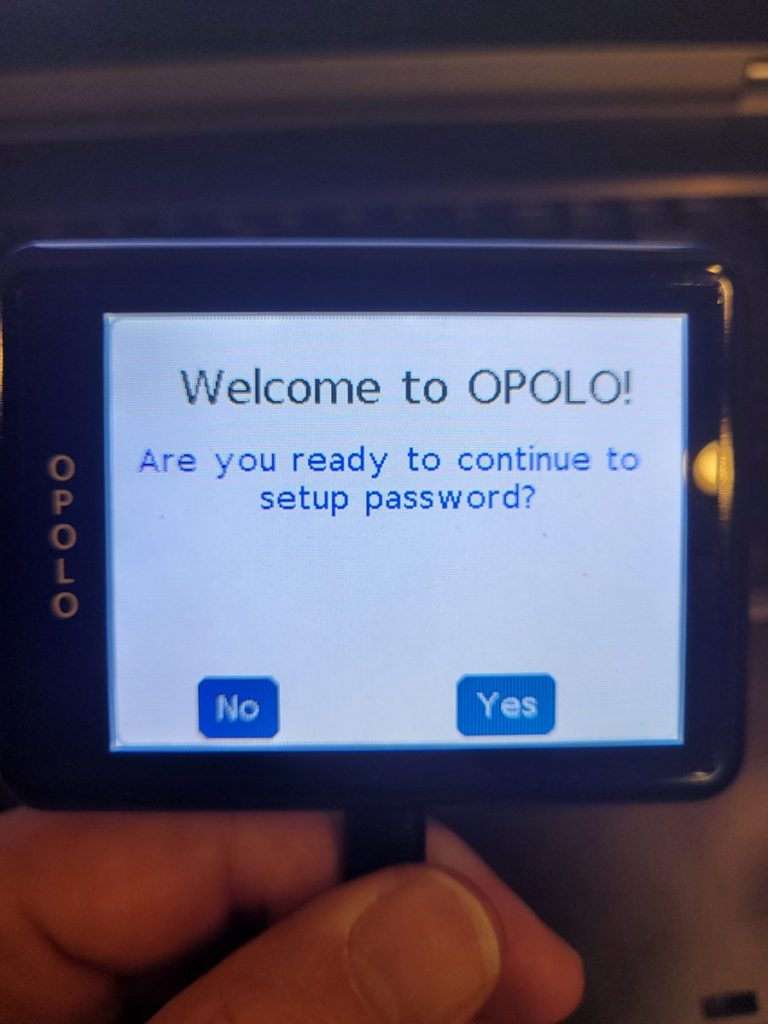
Upon pressing “Yes” you will be sent to the password setup screen where you need to type the password you want to set up and confirm it. OPOLO supports passwords of up to 120 characters. Do not set up a password longer than this. After entering the password you’ll be asked to confirm it by entering it again. Following that you’ll be prompted to enter your password once again to authenticate the device after which you’ll be directed to download the OPOLO app.
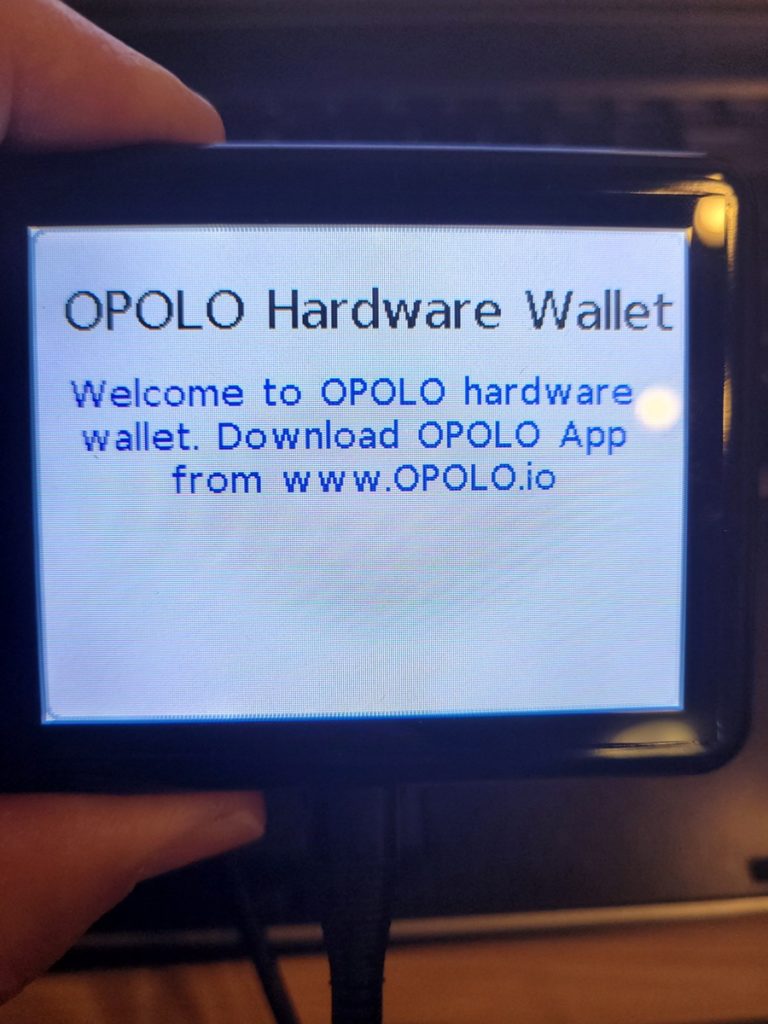
Remember there are only 7 attempts you have to authenticate, and these attempts are being incremented for every failure until you get a success. On success, the tries count resets to zero. So be very careful while entering your password, if you have exceeded the failed attempts then you will not be able to use the wallet anymore. To avoid stealing of the seed, the wallet removes all data from the device and block it for further use. So do not enter the wrong password more than 7 times.
Create a Wallet
Before creating a wallet, you must have completed the prior step to set up the password. If you haven’t done that yet go back and do it now. If you’ve done it already you’re being presented with the screen on your hardware device to download the OPOLO app.
Go to OPOLO.io/download to download the latest version of OPOLO Desk for your operating system.
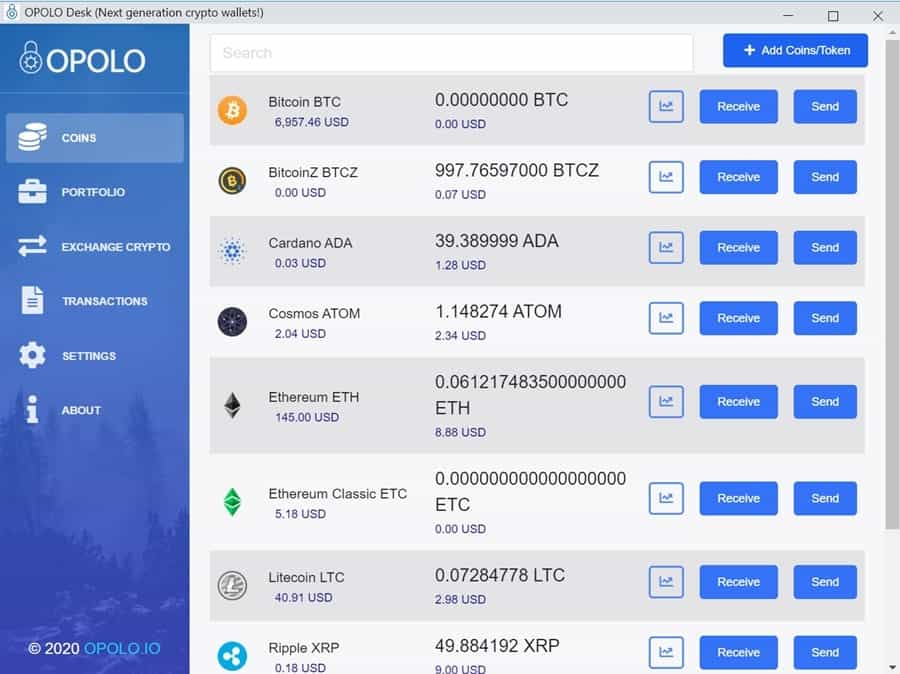
Once the app is installed you’ll need to pair the device and the app. It’s simple enough to do. With the wallet still plugged in and authenticated, and the OPOLO app open you want to click the button that says “Pair USB”.
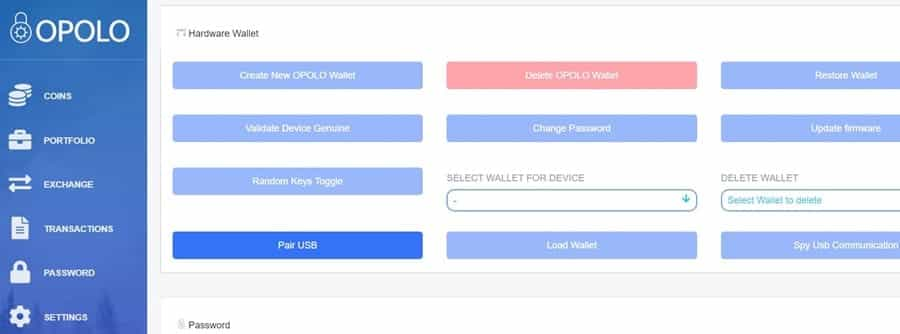
A smaller window will open that shows which USBs are connected. Select the USB with the name “OPOLOC” or “InterBiometric” and click “Connect” to pair the device. This step is critical, if the device is not paired, you cannot perform any operations with the device.
You will be required to enter your password on the device again to authenticate and if the pairing is successful you’ll see a small green box pop up in the desktop app telling you so. All pf the actions in the app will now be available. You may also get a popup asking you to update the firmware of the wallet. If you do get this take care of it now.

Warning: This is a very very sensitive step, if anything is done wrong, it can brick your OPOLO device. Follow the instructions posted on the OPOLO Cosmos Wiki here closely to ensure the firmware is updated properly.
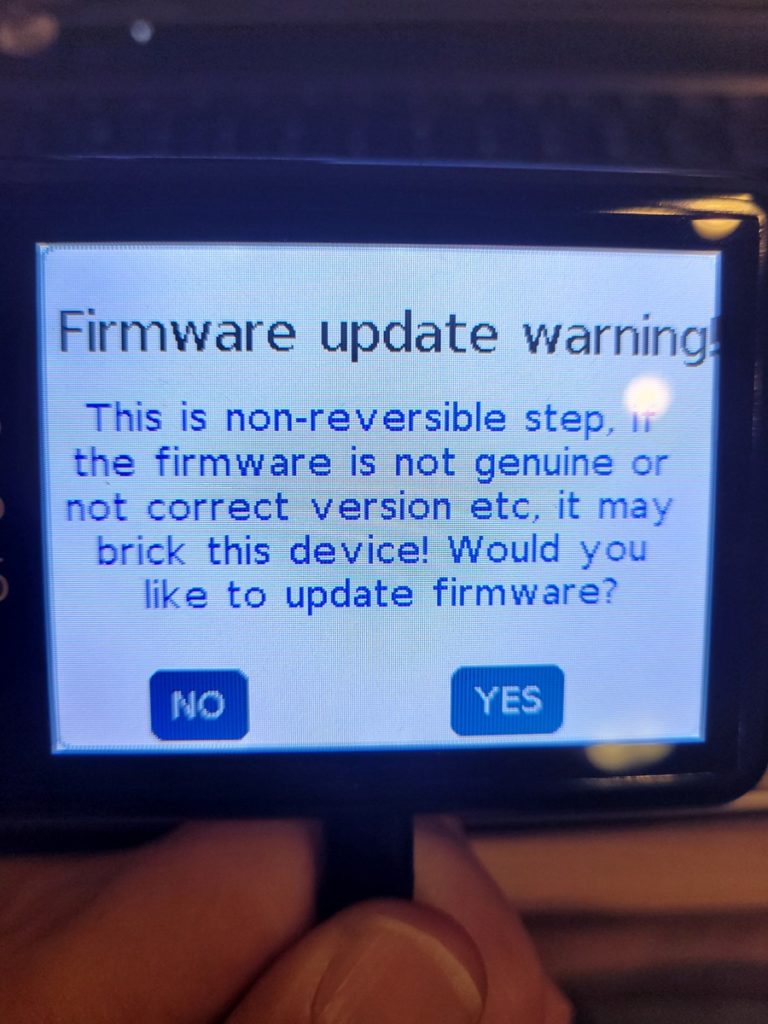
Now you can create a new wallet by pressing the “Create New OPOLO Wallet” in the OPOLO App. The instructions for creating the wallet will appear on the OPOLO device.
First, you will see the 24 words BIP39 mnemonics. You must write them down on paper, and it’s best if you make multiple copies. Each copy should be stored securely in a different location. Or if you have a crypto steel, note it down on there. This is very critical, if you lose this backup, you may lose all your funds. So make multiple copies of written mnemonics and put them in a secure place. You must must must take 3-4 backups on paper or steel.

Next you will be asked if you would like to take a backup on the OPOLO Card. This is an optional step, but this makes life easier when you need to restore the OPOLO wallet. But this shouldn't be the only backup you have. You must keep your paper or steel backups in case of a potential Card failure.
Place the OPOLO card under the device (on the backside) and press “Next”, on a successful backup, you will see a message with success. If you get a failure, readjust the position of OPOLO Card on the backside of the device and press “Retry.” I received two failure message and a small adjustment of the card fixed the problem so the backup was successful on the second try.
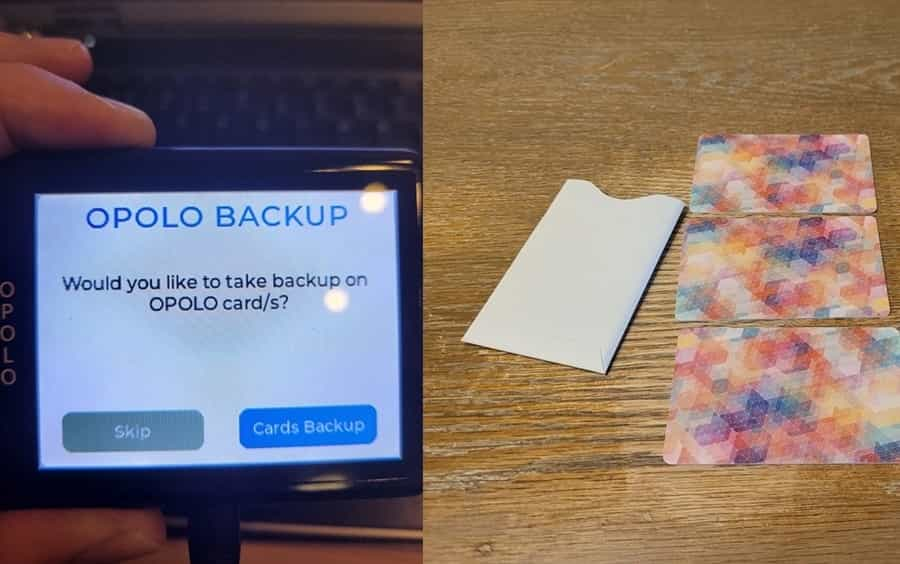
When you successfully save the mnemonics on the card, please carefully store it in a very secure location. Someone who gets the card can restore the wallet. Please consider it as similar to paper with mnemonics written on it.
Now your wallet is set up, you can add some coins and tokens, generate your first address, and get some funds on it.
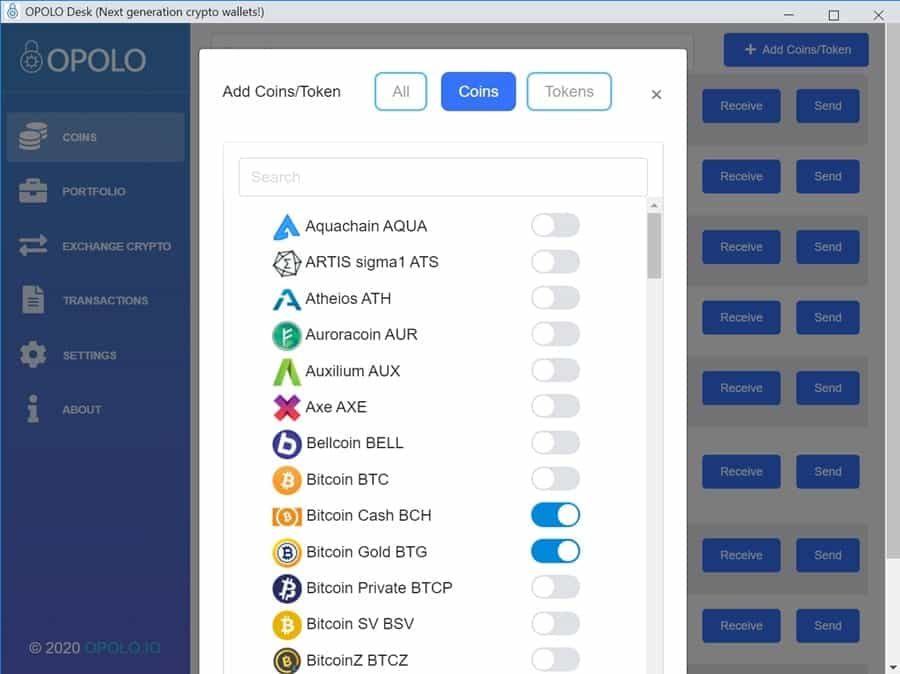
Conclusion
The OPOLO is not only the most secure hardware wallet now on the market thanks to the EAL6+ certifications, it is also the easiest hardware wallet I’ve ever used. The integration of so many coins and the simple interface is a joy if you’ve ever had to download and manage multiple wallets on another hardware device.
I was also pleased with the fairly large device that made it easy to press the correct buttons on the touchscreen. If you have smaller hands you might not be bothered, but if your hands are large and clumsy like mine you’ll also really appreciate the larger touchscreen.
Setup is fairly quick as well. Even while taking notes and pictures for this review, and needing to update the firmware, it took me just 30 minutes from unboxing to adding coins to the wallet. I imagine you could easily cut that to 10 minutes or less if you weren’t documenting all the steps or updating the device firmware.

And I haven't forgotten the promise of a free OPOLO Hardware Wallet. We are giving one away to our readers who follow these steps:
- Comment below what you like/dislike in the OPOLO wallet and what you would wish to see in future versions of OPOLO wallet.
- Follow @OPOLOwallet Twitter and Telegram channel.
- Share the following link with your social network: coinbureau.com/out/opolo
Note that this link will also get you or anyone else who clicks through and purchases an OPOLO wallet gets a 51% discount & VIP access on the crowdfunding launch. So even if you don't win the free OPOLO wallet you can still get one for more than half off, which is a pretty sweet deal on the most secure hardware wallet on the market.
Benefits:
- Get your OPOLO for just €147 (a full 51% OFF retail price of €297).
- As a VIP, you will receive a private invite to be part of OPOLO private groups for VIP members on Facebook and Telegram.
- You will also receive a referral link which you can share across your network to earn $10 for each wallet sale.
- You'll have the coolest and most secure hardware wallet on the planet.
Disclaimer: These are the writer’s opinions and should not be considered investment advice. Readers should do their own research.
